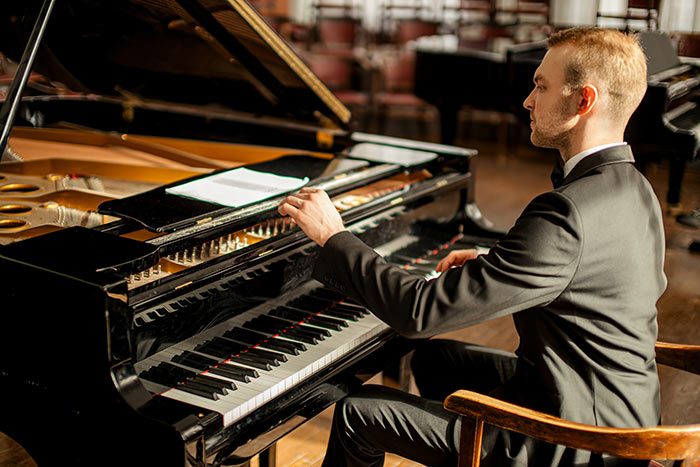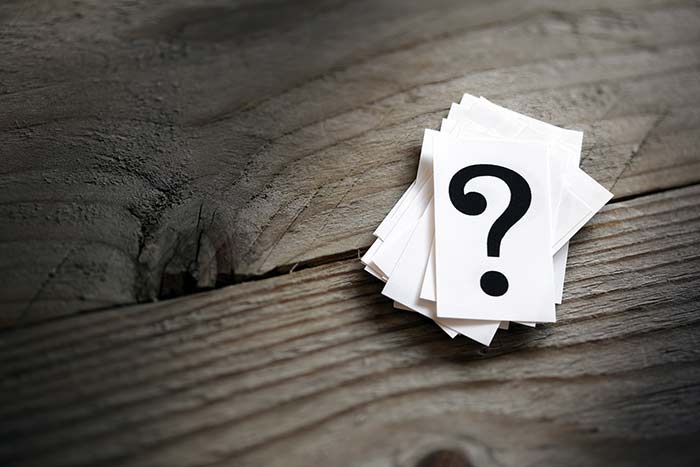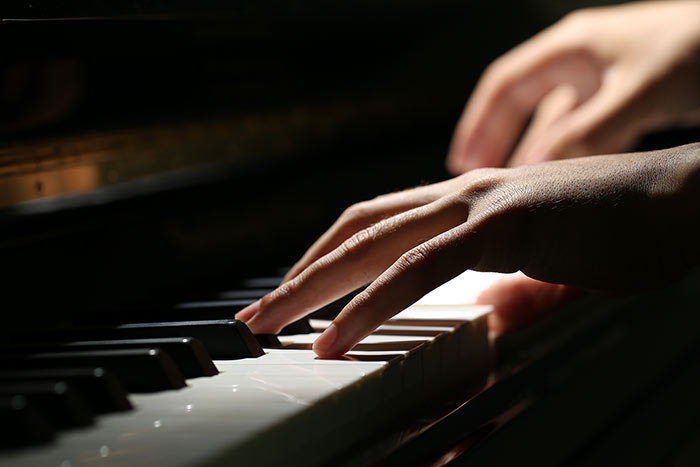Mastering the Art of Pedal: The piano, with its magnificent resonance and versatility, is a captivating instrument capable of producing a wide array of tones and emotions. Central to unlocking the piano’s expressive potential is the judicious use of the pedal. The piano pedal is an essential tool that can transform your playing from ordinary to extraordinary, adding depth, color, and richness to your music. In this article, we delve into the art of pedal technique, exploring its various types, applications, and the nuances that elevate your piano playing.

Understanding the Pedals before we delve into the intricacies of pedal technique, it’s essential to understand the different pedals found on a standard piano:
1: The Sustain Pedal (Damper Pedal): Located on the right, the sustain pedal is the most commonly used pedal. When depressed, it lifts all the dampers away from the strings, allowing the notes to sustain, resonate, and blend together.
2: The Soft Pedal (Una Corda Pedal): Positioned on the left, the soft pedal alters the sound by shifting the hammers closer to the strings, striking fewer strings per note. This creates a softer, more delicate tone.
3: The Sostenuto Pedal: Usually found in grand pianos, the sostenuto pedal sustains only the notes that are being held down when the pedal is engaged. It’s useful for maintaining specific notes while allowing others to decay naturally.

Now, let’s explore how to use sustain pedal effectively in your piano playing.
The Sustain Pedal: A Symphony of Resonance
1: The sustain pedal, often simply referred to as “the pedal,” is the pianist’s primary tool for shaping the piano’s sound. Its judicious use can make the piano sing with warmth and resonance.
2: Legato Playing: To create smooth legato lines, depress the sustain pedal at the beginning of a phrase and release it at the end. This ensures that the notes blend seamlessly, enhancing the lyrical quality of your playing.
3: Enhancing Resonance: For a lush and resonant sound, use the pedal when playing chords or wide arpeggios. The sustained harmonies create a rich sonic tapestry, especially in pieces like Chopin’s Nocturnes or Rachmaninoff’s compositions.
4: Piano Dynamics: Experiment with pedal dynamics. Pressing the pedal gently allows some dampers to touch the strings, resulting in a softer, muted sound. Conversely, a full pedal produces a full, vibrant resonance.
Pedal Techniques and Artistry Pedal technique is not solely about when to engage the pedals but also how to use them effectively:
1: Half-Pedaling: This advanced technique involves partially depressing the sustain pedal, allowing some dampers to touch the strings while others are lifted. Half-pedaling creates a range of nuanced and expressive effects.
2: Pedaling Patterns: In pieces with rapid passages, experiment with pedal patterns that complement the music. For instance, alternating quick pedal lifts and depressions can prevent muddiness in complex runs.
3: Listening and Experimentation: Train your ears to listen critically to your playing. Experiment with different pedal techniques and listen to how they affect the tone and resonance. Developing a discerning ear is essential to achieving mastery.

Pedal Technique and Musical Styles Different musical styles and periods may require variations in pedal technique:
1: Classical: Classical compositions often demand precise pedal technique, with a focus on clarity and precision. Be vigilant about pedal changes to maintain transparency in the music.
2: Romantic: Romantic-era music, with its emphasis on expression and emotion, often benefits from rich sustain pedal use. It allows for a full, passionate sound.
3: Contemporary: Contemporary compositions may challenge traditional pedal techniques, exploring avant-garde effects and innovative pedal usage. Be open to experimentation in this genre.

Conclusion:
Elevating Your Piano Playing with Pedal Precision The piano pedal is a powerful tool that can elevate your playing to new heights of expression and artistry.
Mastery of pedal technique requires practice, patience, and a keen ear. As you embark on your pedal journey, remember that each note you play should be an intentional act, guided by your artistic vision and the nuances you wish to convey.
With diligent practice and a deep understanding of pedal technique, you’ll unlock the full potential of the piano, allowing your music to resonate with emotion, colour, and resonance, captivating both yourself and your audience.
As you navigate the intricacies of pedal precision and explore the vast landscapes of musical expression on the piano, remember that your journey is a continuous evolution of skill and artistry.
At London Piano Institute, we are committed to guiding you through this transformative process. Our piano lessons are crafted to hone your technique, nurture your artistic vision, and elevate your playing to new heights.
Embrace the joy of intentional musical storytelling, where each note becomes a brushstroke on the canvas of your unique musical narrative.
Unlock the full potential of the piano with us at London Piano Institute and embark on a fulfilling journey of mastery. Explore our tailored piano lessons and let the resonance of your music captivate both you and your audience.







